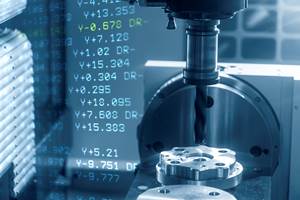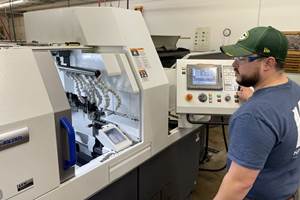Streamlining the Data Network Inside a Machine
As machine tools become more capable of generating data about events and changes that occur within the machine’s internal control system, and the “smart” sensing or measuring devices connected to it, managing this inner network becomes a challenge.
Share





As machine tools become more capable of generating data about events and changes that occur within the machine’s internal control system, and the “smart” sensing or measuring devices connected to it, managing this inner network becomes a challenge. As a solution, Marposs has introduced a new concept in process control systems, called BLÚ. According to the product manager, Frank Powell, BLÚ is derived from the company’s roots in electronic systems for machine tool applications. “We now have a system that is based on a distributed network. It consists of a central processing unit located in the machine control panel, and functional nodes for controlling gages, sensors and other devices distributed throughout the machine,” he says.
BLÚ is part of Marposs’ Industry 4.0 “smart factory” initiative, as it facilitates data sharing among various control system devices. Initially, the company is focusing on applications within grinding machines, but the technology promises to make it easier for other machine tool OEMs to “load up” a machine with sensors, gages and other devices that enhance condition monitoring, predictive maintenance and performance reporting.
Mr. Powell says this modular system reduces the cost of installation and maintenance. “A cable for every device is no longer needed, but rather a single cable for the entire system.” The system can be adapted for a variety of uses, from simple control applications through complex integrated production and control systems.
The BLÚ system architecture enables real-time communication between the various internal and external machine functions. The modular system is comprised of a central processing unit located in the machine’s control panel with compact nodes to control functions such as part flagging, gage electromechanical actuation and in-process measurement, acoustic emission sensing, wheel balancing, and process monitoring. The modular architecture enables users to modify the system according to their specific requirements by adding the necessary function nodes and the associated application software packages.
For now, however, the architecture of its network nodes supports technical solutions for machine tools based on current Marposs measuring and process control sensors, which are tailored for grinding machine applications.
The individual system elements that make up the control network may be connected together at various distances from each other, depending on the layout of the specific machine. The system includes nodes that can be positioned inside the cabinet, and others that can be installed close to the working area and are suitable for harsh environmental conditions.
Just as an external shop network relies on operating software for functionality and efficiency, a data network within a machine also relies on software meeting similar requirements. In this case, Mr. Powell says, the BLÚ system software is designed along the lines of interactively programmable operating cycles displayed in a language that has intuitive menus and a customizable human interface. The system has been designed so that the machine programmable logic controller management uses as few I/O signals as possible. It can be installed as a slave in current PLC networks. The system also includes self-diagnostic software.
Because grinding technology is rapidly evolving and becoming more capable, developers at Marposs designed the BLÚ system for a sampling frequency of 45,000 Hz and a measurement resolution of 10 nanometers. This makes it ready for increases in machine-axis resolution and material-removal rates, regardless of the type of surface being processed, in the next generation of grinders. However, this capability also adds value to applications in other types of machine tools.
Details on this control network can be found at or by contacting Marposs Corp. at 248-370-0404.
Related Content
Cutting Part Programming Times Through AI
CAM Assist cuts repetition from part programming — early users say it cuts tribal knowledge and could be a useful tool for training new programmers.
Read MoreTips for Designing CNC Programs That Help Operators
The way a G-code program is formatted directly affects the productivity of the CNC people who use them. Design CNC programs that make CNC setup people and operators’ jobs easier.
Read MoreOrthopedic Event Discusses Manufacturing Strategies
At the seminar, representatives from multiple companies discussed strategies for making orthopedic devices accurately and efficiently.
Read MoreERP Provides Smooth Pathway to Data Security
With the CMMC data security standards looming, machine shops serving the defense industry can turn to ERP to keep business moving.
Read MoreRead Next
A New Frontier in Surface Finish Control
What if your machine tool could measure surface roughness as it cuts? This article explores how in-process metrology is advancing from concept to reality, enabling real-time feedback, immediate detection of anomalies and new levels of control over surface quality. Discover the technologies making this possible.
Read MoreHow I Made It: Dennis Rymanowski
Dennis Rymanowski has worked at NSH USA for 60 years, with his passion for manufacturing living alongside his passion for his family’s polka band.
Read More


















